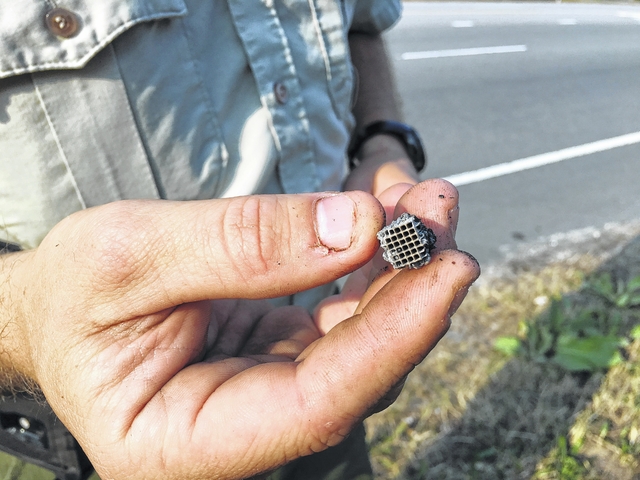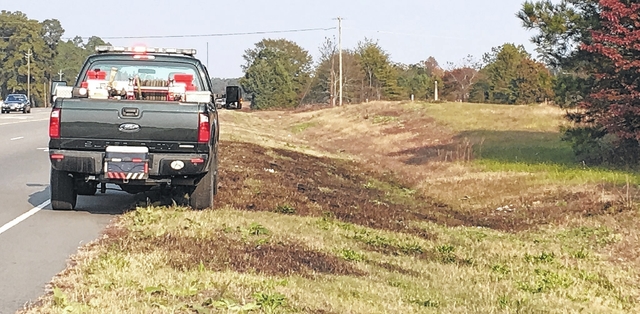MARSTON — A cause of a roadside fire Tuesday afternoon was a common, yet not-commonly known, culprit.
“Particles from the inside of an exhaust pipe, catalytic converter, caused it,” Matt Gordon, Richmond County ranger with the N.C. Forest Service said. “Evidently when somebody hit the gas too hard, it blew it out. I’ve got a handful of probably 20 pieces or more that I’ve walked along and picked up at every little spot.”
Gordon and Franklin McKay of the Hoffman Fire Department responded to the blaze between Marston Road and Cashion Street shortly before 3 p.m.
The burning grass beside the highway, Gordon said, was extinguished quickly despite the dry and windy conditions — but left about 20 feet of scorched land in its wake.
The ranger held up a piece of material he said sparked the fire.
“We call it honeycomb, because that’s what it looks like,” he explained. “It’s actually part of the inside of the muffler, where the catalytic converter is. When these things come out, they’re…around twelve-hundred degrees.”
According to Gordon, most fires that break out on roadsides are not caused by tossed cigarettes as many people believe.
“This is more common of what will start a fire on the side of the road,” he said, turning the piece of honeycomb in his hand. “Or sometimes, something dragging asphalt, rather than a cigarette. It’s fairly common. Most of the time we go to fires on the bypass, U.S. 1, and the most highly traveled areas that are just off the shoulder of the road, this is what it is.”
Gordon said local conditions are currently not conducive to the kinds of fires being battled in the N.C. mountains.
“Any day’s a danger for a fire, but as far as conditions, they are in a prolonged, extreme severe drought,” he explained. “I know they’ve gone over 40 days without a measurable amount of rain, and so when it burns, it’s burning deep into the ground. You can’t just spray it with water because the ground’s still burning, so you’ve actually got to get a real good, 100 percent mop-up job where it’s all out along your containment lines, ‘cause if not, it keeps smoldering and it will spot over your containment line and keep going.”
He said the potential for widespread wildfires is further determined by the presence of various types of debris.
“You’ve got big fuels like logs that are laying there,” Gordon explained. “They are completely burning up. That contributes to fire intensity, fire danger — as far as if a fire spots an ember out and it lands in a small log or something like that on the other side of the line, it could easily sit there and smolder and we would never know it until after a couple of days. It can drop embers down and then the fire starts again after you thought it was stopped.”
He said the dryness of fuels on forest floors combined with elevation create an environment that can easily lead a fire to spread rapidly.
“Fire’s going to burn uphill faster than it will flat,” Gordon added. “They don’t have to have a whole lot of wind for a fire to start at the bottom of a slope, and it’s just going to run up high because its preheating itself, and it’s like a ladder. It jumps on up.”
Meteorologists in the Charlotte area warned residents Tuesday afternoon that they can expect to see “smoky conditions” Wednesday in the city.
“I don’t think we’ll see any of that this far in,” Gordon said. “It’s all going to depend upon whether we have a west or a semi-northwest wind. Most of the time, the majority of the smoke is going up and is dispersing in the upper atmosphere, but if it continues to burn and burn and burn with intensity, and we don’t have days where the upper layer of the atmosphere can disperse the smoke, it’s possible. But, it’s a long ways from the mountains to here.”
Reach reporter Melonie McLaurin at 910-817-2673 and follow her on Twitter @meloniemclaurin.



